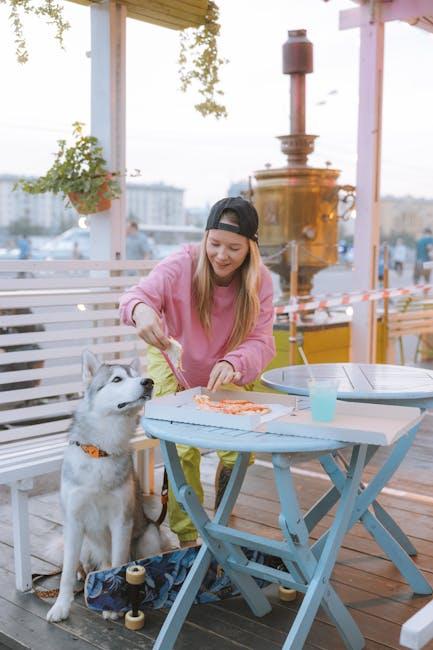Understanding your dog’s caloric needs is an essential part of ensuring their overall health and well-being. Just like humans, dogs require a balanced diet to maintain their energy levels, support growth, and promote a healthy lifestyle. However, determining the right amount of food for your furry friend can be a bit of a puzzle, with factors such as age, breed, activity level, and health status all playing a crucial role. In this article, we’ll guide you through the process of calculating your dog’s caloric requirements, helping you make informed decisions that cater to their unique needs. With a little knowledge and attention, you can ensure that your beloved pet receives the nourishment they need to thrive, leading to a happier and healthier life together.
Determining the Right Calorie Count for Your Dog
To ensure your furry companion is getting the right amount of nourishment, it’s essential to calculate their daily caloric needs. Factors such as age, breed, activity level, and health status all play a significant role in determining the optimal calorie count. For example, a lively Border Collie will require more energy than a laid-back Bulldog. It’s important to consider the following when assessing your dog’s dietary requirements:
- Age: Puppies need more calories per pound compared to adult dogs for growth and development.
- Activity Level: Energetic dogs or those participating in regular training sessions will have higher caloric demands.
- Breed and Size: Larger breeds generally require more calories, but metabolism can vary significantly between breeds.
- Health Considerations: Conditions such as obesity or metabolic disorders may necessitate tailored calorie counts.
Consulting with your veterinarian can provide personalized insights, ensuring your dog receives the right balance of nutrients for their unique lifestyle and needs.

Recognizing Signs of Overfeeding and Underfeeding
Ensuring your dog maintains a healthy weight is essential for their overall well-being. Overfeeding can lead to obesity, putting your pet at risk for a host of health issues like joint problems, diabetes, and heart disease. Common signs that your dog may be overfed include:
- Visible weight gain
- Difficulty breathing or decreased stamina
- Fat deposits over the ribs and tail base
- Reluctance to engage in physical activities
On the other hand, underfeeding can be equally detrimental, leading to malnutrition and a weakened immune system. Signs that your dog might not be getting enough to eat include:
- Visible ribs, spine, and pelvic bones
- Low energy levels and lethargy
- Frequent illnesses or poor coat condition
- Persistent begging for food
Paying close attention to these signs can help you adjust your dog’s diet accordingly. Always consult with your veterinarian to determine the optimal caloric intake tailored to your dog’s age, breed, and activity level.

Choosing Nutrient-Rich Foods for Balanced Energy
Ensuring your dog receives a diet that supports their energy levels involves more than just filling their bowl. It’s about selecting foods that are packed with the right nutrients to sustain them throughout their daily activities. Incorporating high-quality proteins is crucial, as they are the building blocks of muscle and play a vital role in energy production. Look for ingredients like chicken, beef, or fish as primary components in your dog’s meals. Additionally, healthy fats such as those found in fish oil or flaxseed are essential for maintaining a shiny coat and optimal brain function, while also providing a concentrated source of energy.
- Complex Carbohydrates: Opt for whole grains like brown rice or oats, which provide steady energy release.
- Vitamins and Minerals: Ensure a variety of fruits and vegetables are included, such as sweet potatoes and carrots, which are rich in antioxidants.
- Fiber: Sources like pumpkin or green beans can aid digestion and help maintain a healthy weight.
Remember, each dog’s needs are unique, so it’s important to adjust their diet based on age, breed, and activity level. By focusing on nutrient-rich foods, you’ll not only fuel your dog’s energy but also support their overall health and happiness.

Creating a Tailored Feeding Schedule for Your Furry Friend
Every dog is unique, and their energy requirements can vary based on factors such as age, breed, activity level, and health status. To create a feeding schedule that meets your dog’s caloric needs, it’s essential to consider these individual characteristics. Start by consulting with your veterinarian to determine the appropriate daily caloric intake for your furry friend. This can help you understand the balance of proteins, fats, and carbohydrates needed for their optimal health.
Once you have an understanding of their caloric requirements, consider the following when designing their feeding schedule:
- Age and Growth: Puppies require more frequent meals and higher calorie intake compared to adult dogs, as they are still growing and developing.
- Activity Level: Active dogs that engage in regular exercise may need additional calories to maintain their energy levels, while less active dogs may require fewer calories to avoid weight gain.
- Breed Considerations: Some breeds have specific dietary needs or are prone to certain health conditions, which may influence their caloric requirements.
- Health Conditions: Dogs with health issues such as diabetes or obesity might need specialized diets that require precise caloric management.
Incorporating these factors into your feeding plan will help ensure your dog receives the nourishment they need, contributing to their overall well-being and happiness. Regularly assess their weight and body condition, and adjust their diet as necessary to keep them in peak condition.

